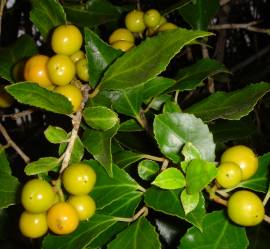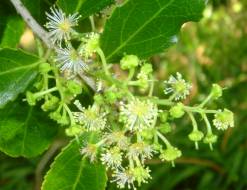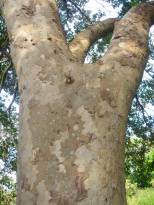Scolopia mundii
Scolopia mundii (Eckl. & Zeyh.) Warb.
Family: Salicaceae
Common names: red pear, mountain saffron (Eng.); rooipeer, doringpeer, bergsaffraan, klipdoring (Afr.); uLoyiphela, umdwendwelencuba, iHlambahlale, inGqumuza, iDungamuzi-lehlathi (Zulu); umkokolo, iQumza, isiNqandizembe, umNqanqa (Xhosa); umThabane (Swazi); mohlono (Northern Sotho)
SA Tree No: 496
Introduction
Scolopia mundii is a graceful and attractive tree producing glossy, dark green leaves and striking yellow to orange fruits. It is relatively widespread in South Africa, occupying both coastal and mountain areas, and its tolerance of high or low light conditions and temperatures enables its cultivation in a range of situations.

Description
Description
Depending on the habitat in which Scolopia mundii is found to grow, it can assume contrasting growth forms shaped by the environmental conditions it is subject to. Under forest conditions it is a medium to tall tree, 10-35 m in height, with a spreading crown and often fluted trunk, up to 1.2 m in diameter. In more open situations, the species attains smaller dimensions, 3-10 m in height, with a compact, dense, and more balanced crown.

The bark is smooth and grey to brown in younger specimens, becoming somewhat rough and flaking with age. Branches are glabrous and may be unarmed or spinescent, the straight spines reaching up to 40 mm in length, usually on young shoots in the leaf axils. Galls reminiscent of fruits may be evident.
The leaves are simple, glabrous and leathery, with serrated margins, and are alternate in their arrangement. Certain Pondoland forms are seen to produce velvety leaves. The leaf veins loop short of the margin and are prominent on both the upper and lower surfaces, in 4-6 lateral pairs. Tertiary venation is evident on the undersurface. They are ovate in shape, tapering abruptly to a slender apex and broadly tapering to rounded at the base. Dimensions vary between 20-80 mm in length and 20-50 mm in width. Petioles are short, 3-10 mm, and are pink to red.
The small, fragrant, green-white flowers, produced from May to August, are borne in dense axillary racemes, 20-30 mm in length. They are bisexual, 4-8 mm in size, with numerous stamens clearly visible.

The fruit, measuring up to 13 mm in diameter, is a smooth, globose berry with a persistent style, containing 1 or occasionally 2, seeds. Fruit maturation and abscission takes 3-4 months, the fruit ripening yellow to orange. Fruiting times are between October and January during which period the profusion of berries lends the tree colour and appeal.
Scolopia mundii can superficially resemble Dovyalis lucida of the same family. The latter, however, is distinguished by the presence of irregular toothing, usually on the upper third of the leaf margin, and by the lack of prominent veins on the leaf undersurface.

Distribution and habitat
Distribution description
Scolopia mundii is a tree of forest and forest margin habitats, and rocky outcrops on grassy mountain slopes, between altitudes of 30 m nearer the coast and 2200 m. in the afromontane belt. It occurs in South Africa from the Cape Peninsula in the Western Cape through to the Eastern Cape, KwaZulu-Natal, Lesotho and Swaziland, and into Mpumalanga, Limpopo, Free State and the North-West. provinces. Although evidently fairly widespread in South Africa, the species is somewhat scattered across its range.
Derivation of name and historical aspects
History
The genus Scolopia comprises around 40 species of trees and shrubs occurring in Africa, Comores, Mascarenes, Madagascar, Malaysia and Australia, of which five species, namely Scolopia mundii, S. flanaganii, S. oreophila, S. stolzii and S. zeyheri, inhabit South Africa. Its members are characterized by leaves that are simple and alternate with minute stipules, the leaf margins entire or serrated, bisexual flowers in inflorescences or solitary exhibiting a unilocular, superior ovary, and fruits that are fleshy berries on which the calyx and style persist (Germishuizen & Meyer 2003).
The generic name Scolopia, derived from the Greek word skolopes, meaning thorn or pointed stick, alludes to the spines produced by many of the species. The species name mundii honours J.L.L. Mund (1791-1831), a Prussian pharmacist and plant collector who arrived in the Cape in 1815.
The family Salicaceae is represented by 9 genera in southern Africa; Dovyalis, Flacourtia, Gerrardina, Homalium, Oncoba, Pseudoscolopia, Salix, Scolopia, and Trimeria. These were part of the family Flacourtiaceae previously. The naturalized poplar species (Populus) also form part of this family.
Ecology
Ecology
Flowers of Scolopia mundii are pollinated through self-pollination as well as by bees in search of pollen. The fruits, which develop and fall after 3-4 months, are spread primarily by birds. Bushpigs are known to consume and destroy fallen fruits, with seeds often being parasitized and subsequently destroyed by insect larvae belonging to the Lepidoptera and Diptera orders (Von Breitenbach 1965). The edible fruits are also consumed by humans. According to Von Breitenbach, seed germination capacity lies at around 40-50%, with germination times observed at between two and three months.
Uses
Use
The tree produces a very strong wood that is close-grained, hard and heavy, and light brown in colour (Von Breitenbach 1965). In the past it was commonly used in wagon construction while its use in furniture-making continues today. Hutchings et al. (1996) comment on the use of the bark in traditional Zulu medicine, the Zulu name for the tree umdwenwelwengcuba pertaining to medicine used in the treatment of heart problems. One fatality is suspected of having been caused by a herbal preparation of this plant.

Growing Scolopia mundii
Grow
Propagation of Scolopia mundii may be carried out from seed and cuttings. Sow ripe seed in a standard seedling mix, ensuring the medium is kept moist. Germination can be expected after 2-3 months, after which seedling growth and development is relatively rapid.
Vegetative propagation is best from tip or heel cuttings, placed in a rich, free-draining medium, preferably in a misting unit to minimize desiccation. It is a somewhat variable species in terms of its growth form and habit, and selection of desirable forms should thus be carried out using vegetative material.
It is well suited to the interior or margins of a forest community in the garden setting, but will do well also in exposed situations where its ornamental foliage and form is seen to best effect. Good flowering and fruiting seasons will further enhance the plant's aesthetics by providing interest and colour, and will no doubt draw the attention of an assortment of bird and insect life. Furthermore, its cold tolerance enables this species to survive in areas not suited to many other of the country's tree species, particularly its more subtropical counterparts.
References
- Germishuizen, G., Meyer, N.L., Steenkamp, Y. & Keith, M. (eds) 2006. A Checklist of South African plants. Southern African Botanical Diversity Network Report No. 41. SABONET, Pretoria.
- Allaby, M. 1998. A dictionary of plant sciences. Oxford University Press, Oxford.
- Coates Palgrave, M. 2002. Keith Coates Palgrave Trees of southern Africa. Struik, Cape Town.
- Germishuizen, G. & Meyer, N.L. (eds). 2003. Plants of southern Africa : an annotated checklist. Strelitzia 14. National Botanical Institute, Pretoria.
- Hutchings, A. 1996. Zulu medicinal plants: an inventory. University of Natal Press, Scottsville.
- Leistner, O.A. (ed.). 2000. Seed plants of southern Africa : families and genera. Strelitzia 10. National Botanical Institute, Pretoria.
- Lotter, M, McCleland, W. & Schmidt, E. 2002. Trees and shrubs of Mpumalanga and the Kruger National Park. Jacana, Johannesburg.
- Palmer, E. & Pitman, N. 1972. Trees of southern Africa (3 vols). Balkema, Cape Town.
- Pooley, E. 1993. The complete field guide to trees of Natal, Zululand and Transkei. Natal Flora Publications Trust, Durban.
- Van Wyk, B. & Van Wyk, P. 1997. Field guide to trees of southern Africa. Struik, Cape Town.
- Von Breitenbach, F. 1965. The indigenous rees of southern Africa. Department of Forestry, Pretoria.
Credits
Jan Burring
Kirstenbosch National Botanical Garden
August 2005
Plant Attributes:
Plant Type: Tree
SA Distribution: Eastern Cape, Free State, KwaZulu-Natal, Limpopo, Mpumalanga, North West, Western Cape
Soil type: Clay, Loam
Flowering season: Winter
PH: Alkaline, Neutral
Flower colour: Green, White
Aspect: Full Sun, Shade, Morning Sun (Semi Shade), Afternoon Sun (Semi Shade)
Gardening skill: Easy
Special Features:
Horticultural zones









Rate this article
Article well written and informative
Rate this plant
Is this an interesting plant?
Login to add your Comment
Back to topNot registered yet? Click here to register.